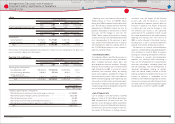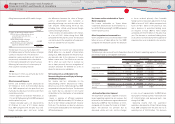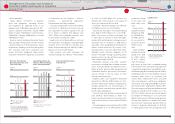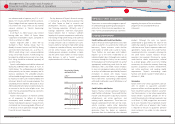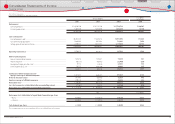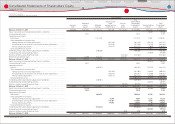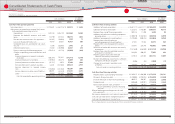Toyota 2010 Annual Report Download - page 57
Download and view the complete annual report
Please find page 57 of the 2010 Toyota annual report below. You can navigate through the pages in the report by either clicking on the pages listed below, or by using the keyword search tool below to find specific information within the annual report.
TOYOTA ANNUAL REPORT 2010 55
was denominated in Japanese yen, 21% in U.S.
dollars, 13% in euros and 30% in other currencies.
Toyota hedges fi xed rate exposure by entering
into interest rate swaps. There are no material
seasonal variations in Toyotas borrowings
requirements.
As of March 31, 2010, Toyotas total interest
bearing debt was 120.8% of Toyota Motor
Corporation shareholders equity, compared to
125.4% as of March 31, 2009.
Toyotas long-term debt is rated AA by
Standard & Poors Ratings Group, Aa2 by
Moodys Investors Services and AAA by Rating
and Investment Information, Inc., as of May 31,
2010. A credit rating is not a recommendation
to buy, sell or hold securities. A credit rating may
be subject to withdrawal or revision at any time.
Each rating should be evaluated separately of
any other rating.
Toyotas unfunded pension liabilities decreased
during fi scal 2010 by ¥106.1 billion, or 16.2%, to
¥547.6 billion. The unfunded pension liabilities
relate primarily to the parent company and its
overseas subsidiaries. The unfunded amounts
will be funded through future cash contributions
by Toyota or in some cases will be funded on the
retirement date of each covered employee. The
unfunded pension liabilities decreased in fi scal
2010 compared to the prior year primarily due to
an increase in the fair value of plan assets. See
note 19 to the consolidated fi nancial statements
for further discussion.
Toyotas treasury policy is to maintain controls
on all exposures, to adhere to stringent
counterparty credit standards, and to actively
monitor marketplace exposures. Toyota remains
centralized, and is pursuing global effi ciency of
its fi nancial services operations through Toyota
Financial Services Corporation.
The key element of Toyotas fi nancial strategy
is maintaining a strong fi nancial position that
will allow Toyota to fund its research and
development initiatives, capital expenditures
and fi nancing operations effi ciently even if
earnings experience short-term fl uctuations.
Toyota believes that it maintains suffi cient
liquidity for its present requirements and that by
maintaining its high credit ratings, it will continue
to be able to access funds from external sources
in large amounts and at relatively low costs.
Toyotas ability to maintain its high credit ratings
is subject to a number of factors, some of which
are not within Toyotas control. These factors
include general economic conditions in Japan
and the other major markets in which Toyota
does business, as well as Toyotas successful
implementation of its business strategy.
Shareholders Equity
and Equity Ratio
0
3,000
6,000
9,000
12,000
15,000
(¥ Billion)
7080 0960FY
0
20
40
60
80
100
(%)
Equity ratio (Right scale)
10
Toyota uses its securitization program as part of
its funding through qualifying special purpose
entities for its fi nancial services operations. See
note 7 to the consolidated fi nancial statements
regarding the impact of the securitization
program on the consolidated fi nancial
statements.
Credit Facilities with Credit Card Holders
Toyotas fi nancial services operation issues credit
cards to customers. As customary for credit card
businesses, Toyota maintains credit facilities
with holders of credit cards issued by Toyota.
These facilities are used upon each holders
requests up to the limits established on an
individual holders basis. Although loans made to
customers through this facility are not secured,
for the purposes of minimizing credit risks and of
appropriately establishing credit limits for each
individual credit card holder, Toyota employs
its own risk management policy which includes
an analysis of information provided by fi nancial
institutions in alliance with Toyota. Toyota
periodically reviews and revises, as appropriate,
these credit limits. Outstanding credit facilities
with credit card holders were ¥130.3 billion as of
March 31, 2010.
Credit Facilities with Dealers
Toyotas fi nancial services operation maintains
credit facilities with dealers. These credit facilities
may be used for business acquisitions, facilities
refurbishment, real estate purchases, and
working capital requirements. These loans are
typically collateralized with liens on real estate,
vehicle inventory, and/or other dealership
assets, as appropriate. Toyota obtains a personal
guarantee from the dealer or corporate
guarantee from the dealership when deemed
prudent. Although the loans are typically
collateralized or guaranteed, the value of the
underlying collateral or guarantees may not be
suffi cient to cover Toyotas exposure under such
agreements. Toyota prices the credit facilities
according to the risks assumed in entering into
the credit facility. Toyotas fi nancial services
operation also provides fi nancing to various
multi-franchise dealer organizations, referred
to as dealer groups, often as part of a lending
consortium, for wholesale inventory fi nancing,
business acquisitions, facilities refurbishment,
real estate purchases, and working capital
requirements. Toyotas outstanding credit
facilities with dealers totaled ¥1,586.8 billion as
of March 31, 2010.
Guarantees
Toyota enters into certain guarantee contracts
with its dealers to guarantee customers
payments of their installment payables that arise
from installment contracts between customers
and Toyota dealers, as and when requested by
Toyota dealers. Guarantee periods are set to
match the maturity of installment payments, and
as of March 31, 2010, ranged from one month
to 35 years. However, they are generally shorter
than the useful lives of products sold. Toyota
is required to execute its guarantee primarily
when customers are unable to make required
payments.
Off -balance sheet arrangements
Lending commitments
Financial Section
Financial Section
Investor Information
Corporate Information
Special Feature
Consolidated
Performance Highlights
Business Overview
Top Messages
Management's Discussion and Analysis of
Financial Condition and Results of Operations






